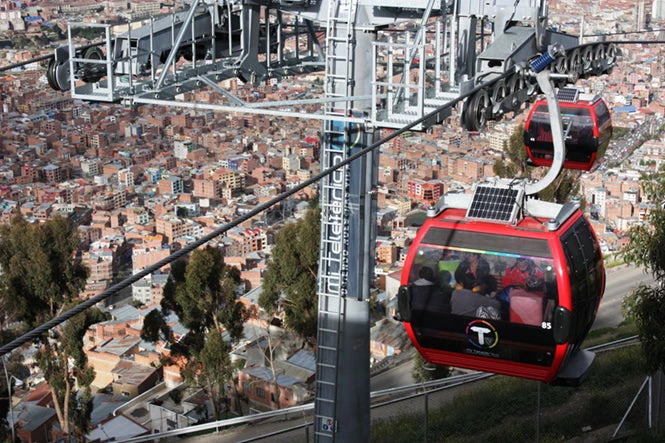Also available in:
Español

Invented over a century ago for exploring mountainous regions, aerial cable cars have recently made an appearance in several big cities, where they are being used as an alternative to conventional urban transport modes. This technology uses electrically-propelled steel cables to move suspended cars (or cabins) between terminals at different elevation points.
The tipping point. The emergence of cable cars in urban transport is fairly new. Medellín, Colombia pioneered the use of cable cars for urban transport when it opened its first “Metrocable” line in 2004. Since then, urban cable cars have grown in popularity around the world, with recent projects in Latin America (Rio de Janeiro, Caracas, Guayaquil, Santo Domingo, La Paz, and Medellín), Asia (Yeosu, South Korea, Taiwan, Hong Kong), Africa (Lagos, Constantine), and Europe (London, Koblenz, Bolzano). Cable cars can be an attractive urban transport solution to connect communities together when geographical barriers such as hills and rivers make other modes infeasible.
Key Considerations. Cable cars are the “hot new topic” in urban mobility right now. However, as with any transport project, cities that are considering investing in a cable car system should carefully consider the advantages and limitations of this technology:
- Implementation Time and Cost. The unique advantage of cable cars is their ability to climb steep hills at a fraction of the investment cost of a new tunnel or bridge. They are also often faster to implement than building new roads, which can appeal to decision-makers looking to show results quickly. Capital costs can vary widely depending on the context, with most Latin American systems ranging between US$10-25 million per km (Figure 3). Critics say that the jury is out on whether cable cars are investment-worthy, and point to a cautionary tale from Rio de Janeiro, where financial troubles caused an indefinite suspension of operations on one of the most expensive urban cable car projects in the developing world.
- Mobility and Accessibility. The recent cable car projects that have received the most attention are those serving poor hillside neighborhoods, many of which were poorly connected to the rest of the city and underserved by conventional transport services. Connecting hilly areas to urban centers by aerial cable cars can bring considerable travel time savings and other socio-economic benefits due to direct linkages and the absence of constraints from road traffic. However, with an average distance of 800 meters between stations, cable cars may not serve as many people as bus services, and require users to walk longer distances to and from the terminals.
- Design and Capacity. The data we compiled from 25 projects in 14 cities shows that urban cable cars have an average route lengths of 2.7-km, operating speeds of 10 to 20 km per hour, and typical operating capacity of 1,000-2,000 passengers per hour per direction. The capacity and accessibility depends largely on the location and design of stations. Based on available data, cable cars are best-suited for areas of moderate travel demand.
- Operations and Maintenance (O&M). Like any public transport system, cable cars require public subsidies for operation and maintenance. While it seems like the O&M costs are highly dependent on the technical features of the system, actual O&M cost data for cable cars is very scarce. Transparent O&M cost data is key to understanding the sustainability of urban cable cars, so we can only encourage cities and operators to share this information.
- User Experience and Other Impacts. User satisfaction is critical to the success of a public transport system. Cable cars have the benefit of giving commuters a “ride with a view,” but they also need high standards of comfort, safety, and security in order to remain popular over time. A well-designed system can also improve the quality of urban space around stations and stimulate urban regeneration. While urban cable car systems are beginning to show positive impacts on the quality of life of users, especially in previously underserved and inaccessible communities, more work is needed to understand their long-run costs and impacts.
In any case, cable cars are an exciting and welcome addition to the toolbox of urban transport planners. These systems, of course, are no alternative to high-capacity mass transit. But they offer an innovative, economical, and complementary solution that could help many isolated hillside residents access jobs and opportunities in the city down below.




Join the Conversation